It’s here. That short, magical period of time when the Morel mushrooms make their appearance across the forests of Pennsylvania. If you’re an avid mushroom hunter, you’ve probably noticed a significant rise in popularity of Morel hunting, especially in Central PA. The roads are lined with cars and people are scattered all over private and public lands. “Morel madness,” some might even say. Being the loving optimist that I am,
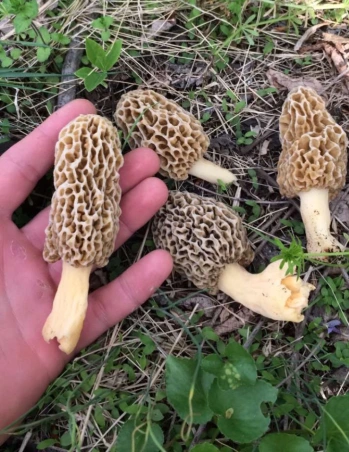
I absolutely LOVE the fact that this random species of mushroom that hides itself among the decaying leaves is so intriguing to people that it draws them out into the woods for hours. It’s borderline inspiring. Personally, I think that Morel mushrooms are bringing wild edible foraging back into the mainstream. Unfortunately, when something pushes the brink of “mainstream” many misconceptions arise from the spread of false information and a general lack of scientific understanding. Many people don’t take the time or see the importance of doing the research required to understand the complexities that are involved in removing a species from the wild. Even if everyone did some online research before going out Morel hunting some level of misinformation and confusion would still exist. Why? Because there are so many articles online that boast false information. The realm of wild edibles is filled with lore, myths, assumptions and hearsay. The research and publications on these subjects are simply not as plentiful as most cultivated species…so we make the mistake of taking the information we find as fact. This has led to a complete misunderstanding of the Morel mushroom and the proper means of harvesting and regeneration. From releasing spores by using mesh bags to the debate on whether to cut them from the ground or pull, there seems to be a level of confusion and controversy. That’s why I’ve decided to provide an article based on scientific evidence, biological understanding, and professional expertise. The original idea for writing this article came from my concern in the rising popularity of Morel hunting. As a self-proclaimed plant nerd, I immediately think of the consequences that exist when wild species are improperly harvested. I began to curiously poke around at the so-called “common practices” surrounding Morel mushrooms hunting. Most importantly, I wanted to understand how Morel’s functioned and if the methods we commonly use were contributing to the sustainability of the Morel population. However, what I quickly came to realize was fungi are ENTIRELY different than plants.. the way they reproduce, they’re physiology, everything.. That’s why I decided that if I was going to provide you with the best quality article I would have to
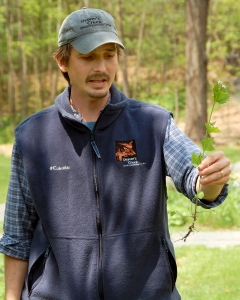
bring in the experts. I had the opportunity to chat with Dr. Eric Burkhart who is a faculty instructor at Penn State in the Department of Ecosystem Science and Management. His areas of expertise include field botany, wild plant conservation & management, and agroforestry practices, just to name a few. He has active research programs dealing with non-timber forest products, most notably his work with American ginseng. After about an hour long conversation, I learned much more than I could ever anticipated about the Morel mushroom. More accurately, I learned that most of the what I did know, was wrong. After speaking with Eric, I realized that the knowledge gap between what is scientific fact and what the common forager knows to be true is more vast than I could have ever imagined.
The “Mesh Bag” Misconception
The biggest misconception that I discussed with Eric was the idea that carrying your Morels in a mesh bag is the best way to allow the spores to escape and produce new mushrooms. Although this is true to a point, there are many other ways that are MUCH 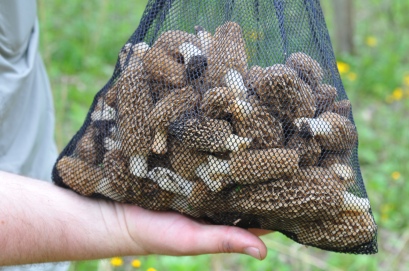 more successful in regenerating Morels. Once I describe the reproductive habits of the Morel mushroom, you’ll quickly understand why this commonly believed practice just doesn’t make much sense biologically. I’ll also explain what ways will be more effective in replenishing that prized plot of Morels.
more successful in regenerating Morels. Once I describe the reproductive habits of the Morel mushroom, you’ll quickly understand why this commonly believed practice just doesn’t make much sense biologically. I’ll also explain what ways will be more effective in replenishing that prized plot of Morels.
The spores of the Morel mushroom are microscopic. The cap of each morel contains approximately 250,000 to 500,000 spores. The spores are generally released during a very short window of time during the mature stages of the mushroom. Morels are Ascomycetes, which means the spores are enclosed within the tissue, and a force propels them out once the mushroom as began to dry (either towards the end of its life cycle or 6-12 hours after it’s harvested). When the spores are released they become airborne and

then fall to the ground in search of soil, moisture, and nutrients. However, the Morel favors a very specific soil environment to reproduce. As you know, when searching for Morels, there are certain host trees they are commonly found at the base of (Apple, Tulip Poplar, Elm, etc). So, if Morels only release their spores in a short window of time after partially drying out, the odds of them being released during the few hours you hike around the woods are slim. I’m not saying some of the Morels in your bag won’t release spores because they may, especially if they are mature ones. What I am saying is, even if a few of your mature mushrooms release spores as you’re walking, the odds of them falling into a place where they can even survive is even smaller. There are multiple ways to regenerate that secret patch of Morels but simply carrying them around in a mesh bag is definitely not the most efficient or effective. Eric walked me through the most common, proven, and effective ways to help your beloved Morels return year after. HOWEVER, this does not mean you should ditch the mesh bag! The mesh bag is still the best choice for other reasons which I will explain later.
3 Proven & Effective Methods for Morel Regeneration
Leave the ugly ones.
I know it’s exciting when you find a patch of Morels and your first reaction is to pick them all. However, simply leaving one or two of the less desirable or “ugly” ones of the bunch will allow that mushroom release it’s spores into an environment that will allow
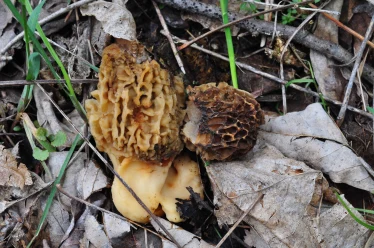
successful reproduction. If for some reason you want to clear all the mushrooms in fear of someone finding your secret Morel stash, simply take the ugly, deformed or bug-ridden mushroom, break it up, and hide it under the leaf litter. Stealthy AND successful. If you are on a private property and would like to establish Morels at other host trees, you take that same mushroom and break it up and scatter it at the base of other Elm’s, Tulip Poplars, etc…
Make a slurry.
This time, pick the ugly mushrooms and take them home with you. Break these undesirable Morels up and toss them in a 5-gallon bucket. Fill the bucket about halfway with water and add some sugar. The sugar will give a boost to the spores once they are ready to germinate. Let this mixture sit for approximately 6-12 hours. Once the time is up, you can pour this mixture at the base of host trees that Morels are commonly found at in your area.
Mushroom burritos.
This one is fun. I think mostly because the name, but it’s also like a little science experiment. Share this one with the kids or any other nerdy adult that you know. This method goes back to the controversy over whether Morels should be cut from the ground or pulled. When you pull the Morels from the ground, the base comes out that is covered in soil and white matter.
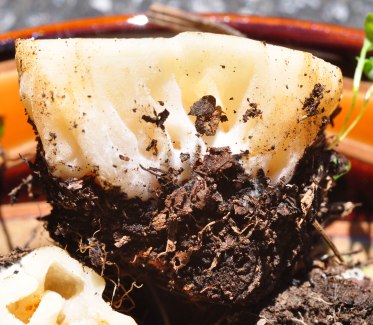
The white root-like structures are called mycelium and are the vegetative body from which the mushrooms (or fruit) grow from. Think of spores as a seed, the mycelium as an apple tree, and the mushroom as the fruit. From the spores, mycelium grows and from the mycelium, Morels will grow. So, understanding this information, you have two choices as a mushroom hunter. 1) Cut the mushrooms so this vegetative body stays in the ground to reproduce another day OR 2) Follow the method I’m about to explain to you. Basically with this “mushroom burrito” method, you’re propagating the mycelium (vegetation) to plant and allow new mushrooms (fruit) to grow from it. You’re basically playing Johnny Morel Mycelium (..that was an attempt at making a bad joke about “playing Johnny Apple Seed”, if you didn’t catch my drift). ANYWAY…Yellow Morels, commonly found in PA, are good for this method because they are mycorrhizal. Keep in mind, not all Morels are mycorrhizal and will not produce in this manner. To begin the process, take a piece of cardboard and soak it in water until it becomes pliable and saturated. Cut off the bottom part of the Morel stem that is covered in soil and mycelium and put that on the cardboard. Once you have all the bases on the card board, roll it up like a burrito and stash it in a plastic bag in a shady place in the house. This process should take about 1-2 weeks. You should check on it periodically because if left too long, the mycelium you are growing could die off. Once a nice, white solid mat begins to form you can remove the cardboard, cut it up into pieces, and plant them at the base of a host tree.

Why Mesh bags are STILL VERY IMPORTANT…
Mushrooms are living organisms, which means they respire and will continue to do so long after they are harvested from the ground. Oxygen is vital for the longevity and quality of your Morels. If you “suffocate” them in a plastic bag, the mushroom’s ability to
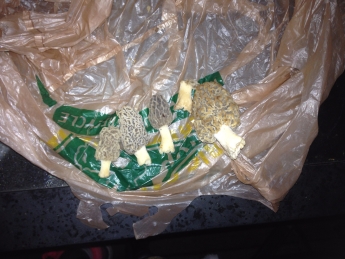
“breathe” or respire drastically decreases. This causes the cells in the mushroom to die off, cell walls to rupture, and enzymatic break down will ensue. Tada – you now have yourself a squishy, brown Morel. So, if you want them to maintain their integrity and texture your best bet is to carry them in something that breathes. My boyfriend, Matt, swears by soft mesh laundry bags. Some people will tell you that old onion bags are perfect but he’ll disagree… for good reason. Morels are very soft and delicate. Often times the thin plastic that mesh onion bags are made out of will nic and slightly cut the heads of the Morels. Although effective for airflow, it’s bad for the quality of the mushrooms. Making any laceration to the mushroom will speed up that browning process that I just mentioned. Another reason plastic bags are a horrid choice biologically is moisture. Remember how I just mentioned mushrooms are still respiring in your bag? Well, with respiration comes water. As a Morel respires, water fluxes in and out of the mushroom. Putting your ‘shrooms in a plastic bag traps the moisture and raises the humidity in the bag. Why is this a bad thing? Well, moisture attracts bacteria. Bacteria produce toxins that damage cell walls. This brings us right back to…yes, squishy, brown, AND SLIMY mushrooms. So, when it comes down to it, always let oxygen in and let moisture out.
Final thoughts…
Writing this article was somewhat of a challenge. It’s truly difficult to find factual information on species such as this where there isn’t a ton of proper research done. Thankfully, there are passionate and dedicated faculty at our Land Grant Universities, such as Penn State, that are willing to share their knowledge and experience. Without the help of Dr. Eric Burkhart this article wouldn’t have been possible. It’s important as we are reading articles on Facebook or other sources that we understand there is A TON of misinformation out there. Always consider the source of your information and don’t settle for anything less than reputable fact. Although the information written about in this article may be the opposite of what you knew to be true, understand that I went through a lot of effort to make sure the information I shared with you comes from experts and published scientific articles on Morel biology. So please, if you have any questions about the information in this article feel free to contact me! On that note, always remember to do your research, be a good steward of the forest, help the Morel’s regenerate, let the air in, the moisture out, and enjoy the fruits of your findings! HAPPY HUNTING!
Citations:
(E. Burkhart, Personal Communication, May 1, 2017)
Volk, T. J. (n.d.). The Morel Life Cycle. Retrieved May 01, 2017, from http://botit.botany.wisc.edu/toms_fungi/morel.html
Pilz, D. (n.d.). Ecology and Management of Morel Harvested From Forests (Tech.). United States Dept. of Agriculture.
Photo Credits:
Dr. Eric Burkhart, Penn State Faculty (Dept. of Ecosystem Science and Mgmt)
Matthew Marshall, PA Game Commission Forester
Thank you for your work in caring for the regeneration of the Morrell mushroom, it is very informative. Too much of nature is neglected and left to waste. Sincerely, J.C. Rumbel;
LikeLiked by 1 person
Thanks for your kind support! Agreed. There needs to be a higher importance of caring for resources we use.
LikeLike
I read this entire article (most times, I do not. The first “misinformation” I see, stops me in my tracks). I started my foraging career with mushrooms (not plants). I have learned, through trial and error, many of the techniques you discuss. Fantastic job!!!! I am a PA forager. I really love the mushroom burrito thing, if you’re trying to spread mycelia. I will try that. However, pulling up the clump at the base should only be done for propagation of mycelia ONLY. I have (regrettably) ruined morel spots by trying to “move” them. This type of propagation should not be attempted by the novice. I say, leave the base until you KNOW what to do with it. Additionally, I like to let my “laundry bag” blow around on the porch to air dry, after I unload a batch… I’ve also been known to put my (empty) bags in waterways for a few hours. I wish the people downstream success as well. 🙂 Great job with your research, every morel hunter should know this stuff and now I can use this to say, “there is a reason for my recommendations”.
LikeLiked by 1 person
Mark, thank you so much for reading! It means so much to me that so many foragers are finding it helpful.. There was so my faulty information I was finding out there I felt the need to do something about it.
I definitely agree with you, if you don’t plan on using the bases for mycelium production just leave them be!
Once again, I sincerely appreciate your feedback. Best of luck with Morel hunting and please share this article with any fellow fungi friends! 🤓
LikeLike
Clearly you have taken a carefully considered position, which I appreciate.
The photo of those Morels in a plastic bag looks like a police crime scene photo. If I may suggest, place a warning beforehand so the visitor may turn away from the horror.
LikeLike